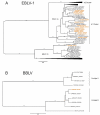Retrospective Enhanced Bat Lyssavirus Surveillance in Germany between 2018-2020
- PMID: 34452403
- PMCID: PMC8402685
- DOI: 10.3390/v13081538
Retrospective Enhanced Bat Lyssavirus Surveillance in Germany between 2018-2020
Abstract
Lyssaviruses are the causative agents for rabies, a zoonotic and fatal disease. Bats are the ancestral reservoir host for lyssaviruses, and at least three different lyssaviruses have been found in bats from Germany. Across Europe, novel lyssaviruses were identified in bats recently and occasional spillover infections in other mammals and human cases highlight their public health relevance. Here, we report the results from an enhanced passive bat rabies surveillance that encompasses samples without human contact that would not be tested under routine conditions. To this end, 1236 bat brain samples obtained between 2018 and 2020 were screened for lyssaviruses via several RT-qPCR assays. European bat lyssavirus type 1 (EBLV-1) was dominant, with 15 positives exclusively found in serotine bats (Eptesicus serotinus) from northern Germany. Additionally, when an archived set of bat samples that had tested negative for rabies by the FAT were screened in the process of assay validation, four samples tested EBLV-1 positive, including two detected in Pipistrellus pipistrellus. Subsequent phylogenetic analysis of 17 full genomes assigned all except one of these viruses to the A1 cluster of the EBLV-1a sub-lineage. Furthermore, we report here another Bokeloh bat lyssavirus (BBLV) infection in a Natterer's bat (Myotis nattereri) found in Lower Saxony, the tenth reported case of this novel bat lyssavirus.
Keywords: Bokeloh bat lyssavirus (BBLV); European bat lyssavirus 1 (EBLV-1); bat lyssavirus; bat rabies surveillance; zoonosis.
Conflict of interest statement
The authors declare no conflict of interest.
Figures


Similar articles
-
Bat rabies surveillance in Europe.Zoonoses Public Health. 2013 Feb;60(1):22-34. doi: 10.1111/zph.12002. Epub 2012 Sep 11. Zoonoses Public Health. 2013. PMID: 22963584
-
Enhanced passive bat rabies surveillance in indigenous bat species from Germany--a retrospective study.PLoS Negl Trop Dis. 2014 May 1;8(5):e2835. doi: 10.1371/journal.pntd.0002835. eCollection 2014 May. PLoS Negl Trop Dis. 2014. PMID: 24784117 Free PMC article.
-
Bokeloh bat lyssavirus isolation in a Natterer's bat, Poland.Zoonoses Public Health. 2018 Dec;65(8):1015-1019. doi: 10.1111/zph.12519. Epub 2018 Sep 9. Zoonoses Public Health. 2018. PMID: 30198169
-
Molecular epidemiology of bat lyssaviruses in Europe.Zoonoses Public Health. 2013 Feb;60(1):35-45. doi: 10.1111/zph.12003. Epub 2012 Sep 3. Zoonoses Public Health. 2013. PMID: 22937876 Review.
-
Public health awareness of emerging zoonotic viruses of bats: a European perspective.Vector Borne Zoonotic Dis. 2006 Winter;6(4):315-24. doi: 10.1089/vbz.2006.6.315. Vector Borne Zoonotic Dis. 2006. PMID: 17187565 Review.
Cited by
-
First data on bacteria associated with bat ectoparasites collected in Kharkiv oblast, Northeastern Ukraine.Parasit Vectors. 2022 Nov 25;15(1):443. doi: 10.1186/s13071-022-05582-3. Parasit Vectors. 2022. PMID: 36434644 Free PMC article.
-
Incursion of European Bat Lyssavirus 1 (EBLV-1) in Serotine Bats in the United Kingdom.Viruses. 2021 Oct 1;13(10):1979. doi: 10.3390/v13101979. Viruses. 2021. PMID: 34696409 Free PMC article.
-
Phylogeographic Aspects of Bat Lyssaviruses in Europe: A Review.Pathogens. 2023 Aug 27;12(9):1089. doi: 10.3390/pathogens12091089. Pathogens. 2023. PMID: 37764897 Free PMC article. Review.
-
Viral Co-Infection in Bats: A Systematic Review.Viruses. 2023 Aug 31;15(9):1860. doi: 10.3390/v15091860. Viruses. 2023. PMID: 37766267 Free PMC article.
-
The Challenge of Lyssavirus Infections in Domestic and Other Animals: A Mix of Virological Confusion, Consternation, Chagrin, and Curiosity.Pathogens. 2025 Jun 13;14(6):586. doi: 10.3390/pathogens14060586. Pathogens. 2025. PMID: 40559594 Free PMC article. Review.
References
Publication types
MeSH terms
Substances
LinkOut - more resources
Full Text Sources

